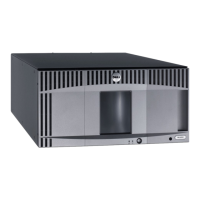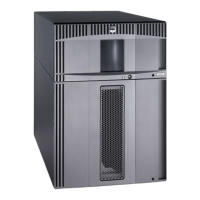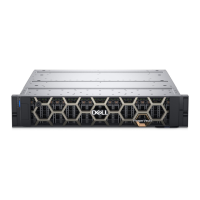Configuring Your Library
file:///T|/htdocs/stor-sys/ML6000/en/html/ch04.htm[9/17/2012 1:49:29 PM]
• Partition Name — limited to a maximum of 12 lower-case alphanumeric characters and underscores (_)
• Media Barcode Format — defaults to Standard. The available options are as follows:
• Standard — (default) Five to 16 characters total, including a barcode number and optional two-character media
ID. If a media ID is included, the label must have a five to 14 character barcode number followed by a media ID;
for example, "XXXXXXXXXXXXXXL4". If a media ID is not included, the label must have a five to 16 character
barcode number; for example, "XXXXX" or "XXXXXXXXXXXXXXXX". Only the barcode number is reported to the
host.
• Standard Six — Six character barcode number with or without a two-character media ID; for example,
"XXXXXXL4" or "XXXXXX". Only the six character barcode number is reported to the host.
• Plus Six — Six character barcode number followed by a two-character media ID; for example, "XXXXXXL4". The
six character barcode and media ID are reported to the host.
• Extended — Five to 16 characters total, including a barcode number and optional two-character media ID. All
characters are reported to the host, regardless of the barcode label having a media ID or not. If a media ID is
included, the label must have a five to 14 character barcode followed by a media ID; for example,
"XXXXXXXXXXXXXXL4". If a media ID is not included, the label must have a five to 16 character barcode number;
for example, "XXXXX" or "XXXXXXXXXXXXXXXX".
• Media ID Last — Five to 14 character barcode number followed by a two-character media ID, for example,
"XXXXXXXXXXXXXXL4". The media ID is reported to the host last, as in "XXXXXXXXXXXXXXL4".
• Media ID First — Five to 14 character barcode number followed by a two-character media ID, for example,
"XXXXXXXXXXXXXXL4". The media ID is reported to the host first, as in "L4XXXXXXXXXXXXXX".
• Number of Slots — the number of storage slots allocated to the new partition.
• Drives — the tape drive or drives assigned to the partition.
Note: Before creating partitions, verify that all tape drives are unloaded. For information on unloading tape drives, see
Unloading Tape Drives.
Note: Creating Partitions operations cannot be performed concurrently by multiple administrators logged in from
different locations. You can access the screen, but you cannot apply changes while another administrator is performing
the same operation.
You cannot create partitions manually from the operator panel. The path to open the appropriate screen is:
• From the Web client, select Setup > Partitions.
Modifying Partitions
Using the Web client, administrators can modify partition settings any time after the partition is created.
The tape drive set as the control path for a particular partition cannot be deleted from that partition. The check box
associated with the control path is grayed out. For more information on setting the control path, see Working With Control
Paths.
The library automatically takes the partition offline before modifying it and places the partition back online after it is modified.
When modifying a partition, you may need to provide the following information:
• Partition Name — limited to a maximum of 12 lower-case alphanumeric characters and underscores (_).
• Media Barcode Format — defaults to Standard. See
Manually Creating Partitions for descriptions of available
options.
• Number of Slots — the number of tape cartridge slots allocated to the partition.
• Drives — the tape drive or drives assigned to the partition.
Note: Before deleting a tape drive from a partition, verify that it is unloaded. For information on unloading tape
drives, see Unloading Tape Drives.
You cannot modify partitions manually from the operator panel. The path to open the appropriate screen is:
• From the Web client, select Setup > Partitions.

